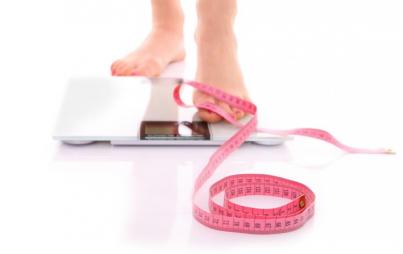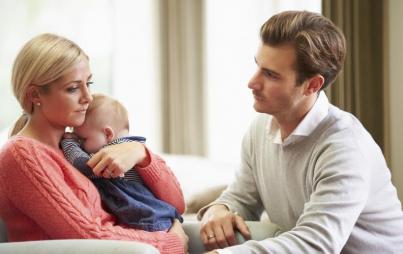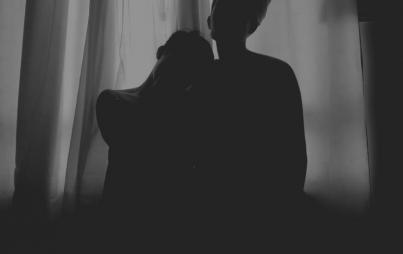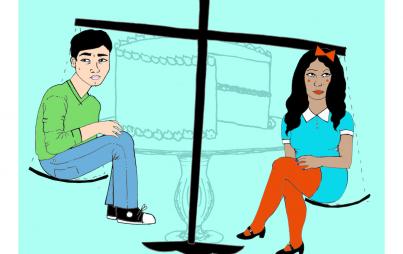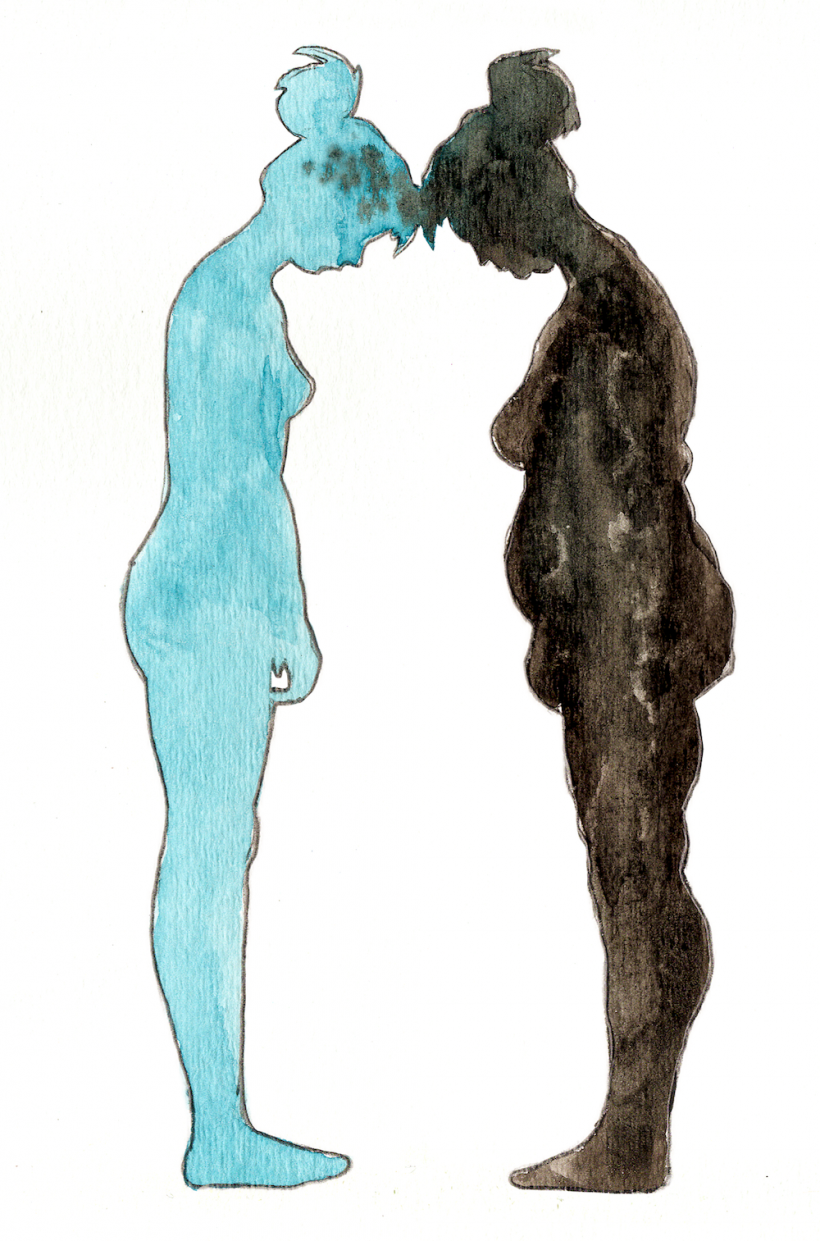
image credit: Mariah Aro Sharp
A bipolar, body-positive bread enthusiast with a jacked-up ankle and a history of disordered eating chronicles health, weight-loss, and gardening. No diets allowed.
CN: dieting, eating disorder, OCD
The camera adds 10 pounds.
That used to be a thing people said to make people feel better about the way they look in photographs, but it’s actually (at least somewhat) scientifically sound. The way the camera punishes you is all about the lens — the width and depth of it — and of course the angle at which you are being photographed.
Yeah. We all know what you’re doing when you take a selfie two feet above your head.
I just took this one in my office/music room (what happens when your kids start moving out? You get sad, but ALSO EXTRA ROOMS!). I haven’t taken a shower. I have no makeup on. On my shoulders is a weighted heating pad that I have recently started wearing all day to try to keep my shoulders out of my ears. I am wearing my mala because the current state of the country requires a constant state of meditation. Oh, and I haven’t brushed my hair.
I look fly though, right? #NOFILTER #NOMAKEUP #NOPROBLEM, boos.
It’s all in the angle.
The other thing about photographs of you, that are not taken by you (besides the 10 pounds thing), is that when you are not behind the lens, you're not able to situate yourself in such a way that your proverbial best face is forward. The person behind the camera sees the actual you, but this isn't unlike hearing your recorded voice played back to you. You don't sound like yourself to your own ear, but you do sound like yourself to everyone else.
I know, it’s kind of a bullshit situation.
Regardless of what the camera or the mirror reflects back at us, many of us don't see that person.
Instead, we see an entirely different person — and it's often a person that we don't particularly like. At its most severe, this is called Body Dysmorphic Disorder. It's a sort of OCD that is characterized by the following:
-
Persistent dissatisfaction with one or more parts of the body. (These imperfections may be real or imagined. It doesn't matter.)
-
Obsession with the perceived imperfection.
-
Attempts to hide, camouflage, or otherwise alter the body.
BDD is treatable like any other mental illness, with a combination of medication and therapy, often using Cognitive Behavior Therapy (CBT).
Most folks don’t have BDD. But many (if not most) are familiar with the idea of not liking what they see in the mirror/camera. In fact, 97% of women report hating some part of their body at some point. Even if objectively you don't look as you imagine you do, your imagination can't be reasoned with.
This is part one of why the diet industry rules — to the tune of $60 billion a year.
(Yeah. I said 60 BILLION.)
I have the pathological version of BDD, but even if you don't have the pathological variety, I’m willing to bet a lot of you can relate to this feeling in a non-pathological way.
Take this for example:
A few years ago, The Daily Mail in the UK asked some women to identify their body-type among this line up:
What number are you?
Would it surprise you to learn that of the four women they asked, nary a one identified a shape that looked like the actual them?
It would not surprise me — because I am one of those women.
This is not your standard, “I’m an apple. I’m a pear,” situation. This is a very real, very destructive matter of super flawed self-image.
I look at that, I see a seven (but really an eight).
I know I'm a five (maybe a six?), because lots of therapy, but if I hadn't had lots of therapy, I'd argue hard for a seven (but more likely an eight).
The photo below is one that was taken of me (and my then 11-year-old son) in 2009:
Another, taken a month before that one (note: thigh):

For the sake of comparison, this is a photo of me taken in November (NOT from the two foot high universally flattering angle):

You may notice a lack of visible collarbone.
The thing about having BDD is that, in my mind, the person in the first photo looks the same as the person in the last photo, and the person in the last photo looks like somone else entirely.
This is how I came to weigh less than I weighed at 15. I was fixated on my belly — skin lax after four pregnancies. I was so fixated on my belly that I kept losing weight with the assumption that at a certain number of pounds lost, my belly would be lost, too.
Two problems with this faulty thinking:
1. You can't lose weight in your uterus (which, in my case, was enlarged [and is now gone]).
2. You can't make skin go away. There is literally no amount of weight you can lose that will make your skin disappear.
3. My stomach didn't/doesn't even look as horrifying as I imagine.
But that's the thing about dysmorphia, you can't just tell someone they are deceived by what they think they see and expect them to be like, "OH! You're right! What was I thinking!?"
It doesn't work that way at all.
The really screwed up thing is, there was never a point at which what I saw in the mirror would have been my real reflection. There was no point at which I would have been satisfied with my stomach because there was never a point at which I could see myself as anything but flawed. There was no stomach that would have met my stomach standards because my standards were built around something that isn't even real.
I ran until I broke my leg. I developed an eating disorder. I lost weight until my breasts and hips were gone — DDs shrunk to a deflated B, size 16 pants traded for 12, then 10, then eight, and finally a baggy four.
I still wasn't content. There was no contentedness to be found in the bottom of an empty bowl of breakfast I barely ate, after an exhausting 13 mile run.
There was just me and my wrinkled skin and my lost sleep and my sadness.
The first step to recovery is acknowledging there is a problem. In this case, the problem is, we don't see the real us. Most of us don't see a form even close to the real us. Therapy helps, but even if you don't have a psychiatrist on speed-dial, you should know that you are not alone. You are one of many many humans whose mirror reflection is not the reflection of their mind's eye. You are one of many many humans whose body, even while it disappoints you, is beautiful to those who see it objectively.
You are one of many many humans who are still trying to figure this life thing out, including me.
All BB&A images are original artwork by Mariah Aro Sharp.



